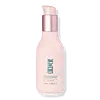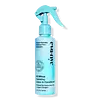What's inside
What's inside
 Key Ingredients
Key Ingredients

 Benefits
Benefits

 Concerns
Concerns

 Ingredients Side-by-side
Ingredients Side-by-side

Water
Skin ConditioningCetearyl Alcohol
EmollientBehentrimonium Chloride
PreservativeCocos Nucifera Oil
MaskingPersea Gratissima Oil
Skin ConditioningButyrospermum Parkii Butter
Skin ConditioningCitric Acid
BufferingPanthenol
Skin ConditioningPotassium Sorbate
PreservativeSodium Benzoate
MaskingQuaternium-80
Parfum
MaskingPolyamide-2
Glycerin
HumectantMoringa Oleifera Seed Extract
Skin ConditioningPropanediol
SolventGlyceryl Stearate
EmollientPhospholipids
Skin ConditioningCocos Nucifera Water
MaskingTetrasodium Glutamate Diacetate
Cocos Nucifera Fruit Juice
EmollientPolyglyceryl-10 Oleate
Skin ConditioningPolyglyceryl-10 Dioleate
EmulsifyingSodium Stearoyl Lactylate
EmulsifyingGlyceryl Undecylenate
EmollientGlyceryl Caprylate
EmollientFicus Carica Fruit Extract
HumectantHydrolyzed Rice Protein
Skin ConditioningCaramel
Cosmetic ColorantWater, Cetearyl Alcohol, Behentrimonium Chloride, Cocos Nucifera Oil, Persea Gratissima Oil, Butyrospermum Parkii Butter, Citric Acid, Panthenol, Potassium Sorbate, Sodium Benzoate, Quaternium-80, Parfum, Polyamide-2, Glycerin, Moringa Oleifera Seed Extract, Propanediol, Glyceryl Stearate, Phospholipids, Cocos Nucifera Water, Tetrasodium Glutamate Diacetate, Cocos Nucifera Fruit Juice, Polyglyceryl-10 Oleate, Polyglyceryl-10 Dioleate, Sodium Stearoyl Lactylate, Glyceryl Undecylenate, Glyceryl Caprylate, Ficus Carica Fruit Extract, Hydrolyzed Rice Protein, Caramel
Water
Skin ConditioningGlycerin
HumectantCetearyl Alcohol
EmollientButylene Glycol
HumectantBehentrimonium Chloride
PreservativeSodium Hyaluronate
HumectantSh-Polypeptide-121
Skin ConditioningOryza Sativa Extract
AbsorbentAlthaea Officinalis Root Extract
Skin ConditioningOlea Europaea Fruit Oil
MaskingPrunus Amygdalus Dulcis Oil
Skin ConditioningSesamum Indicum Seed Oil
EmollientGuar Hydroxypropyltrimonium Chloride
Skin ConditioningQuaternium-80
Tetrasodium Glutamate Diacetate
Lauryl Laurate
Skin ConditioningPanthenol
Skin ConditioningGlycereth-17 Cocoate
EmulsifyingPotassium Sorbate
PreservativeSodium Benzoate
MaskingBenzoic Acid
Masking1,2-Hexanediol
Skin ConditioningEthylhexylglycerin
Skin ConditioningPhenoxyethanol
PreservativeParfum
MaskingWater, Glycerin, Cetearyl Alcohol, Butylene Glycol, Behentrimonium Chloride, Sodium Hyaluronate, Sh-Polypeptide-121, Oryza Sativa Extract, Althaea Officinalis Root Extract, Olea Europaea Fruit Oil, Prunus Amygdalus Dulcis Oil, Sesamum Indicum Seed Oil, Guar Hydroxypropyltrimonium Chloride, Quaternium-80, Tetrasodium Glutamate Diacetate, Lauryl Laurate, Panthenol, Glycereth-17 Cocoate, Potassium Sorbate, Sodium Benzoate, Benzoic Acid, 1,2-Hexanediol, Ethylhexylglycerin, Phenoxyethanol, Parfum
 Reviews
Reviews

Ingredients Explained
These ingredients are found in both products.
Ingredients higher up in an ingredient list are typically present in a larger amount.
This ingredient is a preservative and often used for it's anti-static properties. You'll most likely see this ingredient in hair conditioners.
It does not cause irritation or sensitization in leave-on products at 1-5%.
Cetearyl alcohol is a mixture of two fatty alcohols: cetyl alcohol and stearyl alcohol. It is mainly used as an emulsifier. Emulsifiers help prevent the separation of oils and products. Due to its composition, it can also be used to thicken a product or help create foam.
Cetearyl alcohol is an emollient. Emollients help soothe and hydrate the skin by trapping moisture.
Studies show Cetearyl alcohol is non-toxic and non-irritating. The FDA allows products labeled "alcohol-free" to have fatty alcohols.
This ingredient is usually derived from plant oils such as palm, vegetable, or coconut oils. There is debate on whether this ingredient will cause acne.
Due to the fatty acid base, this ingredient may not be Malassezia folliculitis safe.
Learn more about Cetearyl AlcoholGlycerin is already naturally found in your skin. It helps moisturize and protect your skin.
A study from 2016 found glycerin to be more effective as a humectant than AHAs and hyaluronic acid.
As a humectant, it helps the skin stay hydrated by pulling moisture to your skin. The low molecular weight of glycerin allows it to pull moisture into the deeper layers of your skin.
Hydrated skin improves your skin barrier; Your skin barrier helps protect against irritants and bacteria.
Glycerin has also been found to have antimicrobial and antiviral properties. Due to these properties, glycerin is often used in wound and burn treatments.
In cosmetics, glycerin is usually derived from plants such as soybean or palm. However, it can also be sourced from animals, such as tallow or animal fat.
This ingredient is organic, colorless, odorless, and non-toxic.
Glycerin is the name for this ingredient in American English. British English uses Glycerol/Glycerine.
Learn more about GlycerinPanthenol is a common ingredient that helps hydrate and soothe the skin. It is found naturally in our skin and hair.
There are two forms of panthenol: D and L.
D-panthenol is also known as dexpanthenol. Most cosmetics use dexpanthenol or a mixture of D and L-panthenol.
Panthenol is famous due to its ability to go deeper into the skin's layers. Using this ingredient has numerous pros (and no cons):
Like hyaluronic acid, panthenol is a humectant. Humectants are able to bind and hold large amounts of water to keep skin hydrated.
This ingredient works well for wound healing. It works by increasing tissue in the wound and helps close open wounds.
Once oxidized, panthenol converts to pantothenic acid. Panthothenic acid is found in all living cells.
This ingredient is also referred to as pro-vitamin B5.
Learn more about PanthenolParfum is a catch-all term for an ingredient or more that is used to give a scent to products.
Also called "fragrance", this ingredient can be a blend of hundreds of chemicals or plant oils. This means every product with "fragrance" or "parfum" in the ingredients list is a different mixture.
For instance, Habanolide is a proprietary trade name for a specific aroma chemical. When used as a fragrance ingredient in cosmetics, most aroma chemicals fall under the broad labeling category of “FRAGRANCE” or “PARFUM” according to EU and US regulations.
The term 'parfum' or 'fragrance' is not regulated in many countries. In many cases, it is up to the brand to define this term.
For instance, many brands choose to label themselves as "fragrance-free" because they are not using synthetic fragrances. However, their products may still contain ingredients such as essential oils that are considered a fragrance by INCI standards.
One example is Calendula flower extract. Calendula is an essential oil that still imparts a scent or 'fragrance'.
Depending on the blend, the ingredients in the mixture can cause allergies and sensitivities on the skin. Some ingredients that are known EU allergens include linalool and citronellol.
Parfum can also be used to mask or cover an unpleasant scent.
The bottom line is: not all fragrances/parfum/ingredients are created equally. If you are worried about fragrances, we recommend taking a closer look at an ingredient. And of course, we always recommend speaking with a professional.
Learn more about ParfumPotassium Sorbate is a preservative used to prevent yeast and mold in products. It is commonly found in both cosmetic and food products.
This ingredient comes from potassium salt derived from sorbic acid. Sorbic acid is a natural antibiotic and effective against fungus.
Both potassium sorbate and sorbic acid can be found in baked goods, cheeses, dried meats, dried fruit, ice cream, pickles, wine, yogurt, and more.
You'll often find this ingredient used with other preservatives.
Learn more about Potassium SorbateWe don't have a description for Quaternium-80 yet.
Sodium Benzoate is a preservative. It's used in both cosmetic and food products to inhibit the growth of mold and bacteria. It is typically produced synthetically.
Both the US FDA and EU Health Committee have approved the use of sodium benzoate. In the US, levels of 0.1% (of the total product) are allowed.
Sodium benzoate works as a preservative by inhibiting the growth of bacteria inside of cells. It prevents the cell from fermenting a type of sugar using an enzyme called phosphofructokinase.
It is the salt of benzoic acid. Foods containing sodium benzoate include soda, salad dressings, condiments, fruit juices, wines, and snack foods.
Studies for using ascorbic acid and sodium benzoate in cosmetics are lacking, especially in skincare routines with multiple steps.
We always recommend speaking with a professional, such as a dermatologist, if you have any concerns.
Learn more about Sodium BenzoateTetrasodium Glutamate Diacetate is a chelating agent. Chelating agents help prevent metal ions from binding to other ingredients. This helps prevent unwanted effects and reactions from a product. These metal ions may come from water and are found in miniscule amounts.
Tetrasodium Glutamate Diacetate can also help other preservatives be more effective.
Water. It's the most common cosmetic ingredient of all. You'll usually see it at the top of ingredient lists, meaning that it makes up the largest part of the product.
So why is it so popular? Water most often acts as a solvent - this means that it helps dissolve other ingredients into the formulation.
You'll also recognize water as that liquid we all need to stay alive. If you see this, drink a glass of water. Stay hydrated!
Learn more about Water